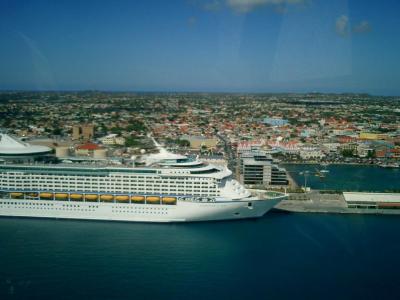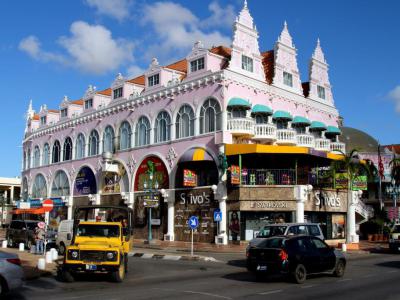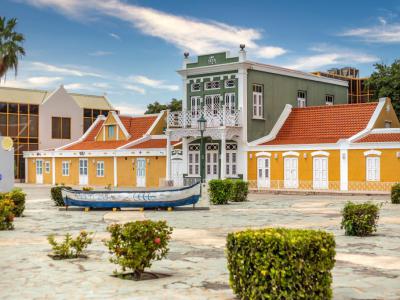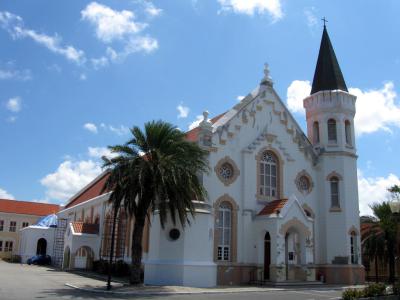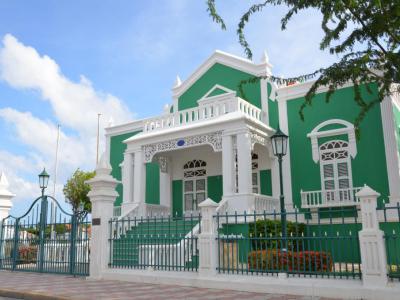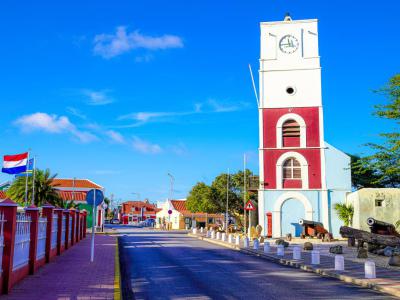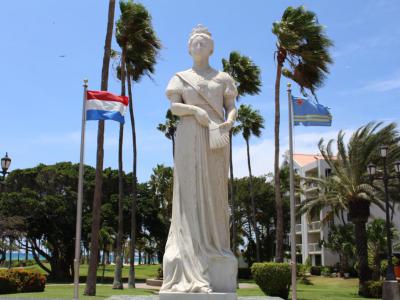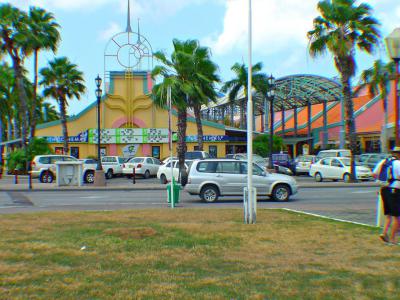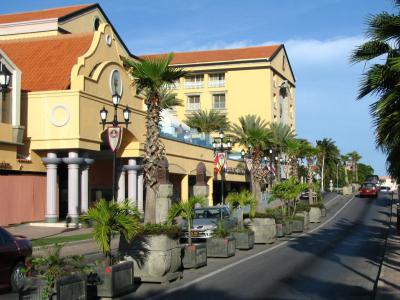Audio Guide: Oranjestad Introduction Walking Tour (Self Guided), Oranjestad
Perched along the Dutch Caribbean Sea shore lies the picturesque capital of Aruba, Oranjestad. The locals still habitually refer to it as "Playa".
European settlers arrived on the island around 1754, establishing plantations along the coast. In 1796, the Dutch authorities built a small fort—Fort Zoutman—on the southern coast to protect the island and assert colonial control. This fort, named after Dutch Rear Admiral Johan Arnold Zoutman, became the nucleus around which the first town developed. Nearby, the Willem III Tower was added in 1868, serving as a lighthouse and clock tower and symbolizing the town’s growing importance.
Oranjestad’s name, meaning “City of Orange,” honors the Dutch royal family, the House of Orange-Nassau. Initially, the settlement grew slowly; by the early 1800s it was a modest port village engaged in livestock exports and small-scale trade with neighboring Curacao and Venezuela. The mid-19th century brought transformation through the aloe trade, which made Aruba one of the world’s leading producers of aloe resin. Later, in the 1870s, the discovery of phosphate deposits on the island further stimulated economic activity, and Oranjestad became the administrative and commercial hub.
In the early 20th century, Oranjestad expanded rapidly following the establishment of the Lago Oil and Transport Company refinery in San Nicolas, which brought prosperity, modern infrastructure, and migration to the island. Though the refinery was located elsewhere, Oranjestad remained the center of governance and trade.
Today's Oranjestad is a bustling hub of activity. One of its highlights is the Aruba Cruise Port, where visitors from around the world arrive to experience the island's warmth and hospitality. Nearby, the outdoor mall at Royal Plaza beckons shoppers with its array of duty-free boutiques, perfect for indulging in some retail therapy.
Oranjestad is also home to several iconic landmarks, such as the San Francisco Church, a beautiful example of Dutch colonial architecture, and the elegant lime-colored City Hall.
History buffs will delight in exploring Fort Zoutman Historical Museum of Aruba, the island's oldest structure. The city's man-made expansion into the sea features notable areas like the Renaissance Marketplace and Queen Wilhelmina Park.
Adorned with vibrant pastel-colored Dutch colonial buildings and swaying palm trees, the alluring city of Oranjestad offers a delightful blend of culture and coastal beauty. With the help of our self-guided tour, you can embark on your own adventure and discover the magic of this Caribbean gem today!
European settlers arrived on the island around 1754, establishing plantations along the coast. In 1796, the Dutch authorities built a small fort—Fort Zoutman—on the southern coast to protect the island and assert colonial control. This fort, named after Dutch Rear Admiral Johan Arnold Zoutman, became the nucleus around which the first town developed. Nearby, the Willem III Tower was added in 1868, serving as a lighthouse and clock tower and symbolizing the town’s growing importance.
Oranjestad’s name, meaning “City of Orange,” honors the Dutch royal family, the House of Orange-Nassau. Initially, the settlement grew slowly; by the early 1800s it was a modest port village engaged in livestock exports and small-scale trade with neighboring Curacao and Venezuela. The mid-19th century brought transformation through the aloe trade, which made Aruba one of the world’s leading producers of aloe resin. Later, in the 1870s, the discovery of phosphate deposits on the island further stimulated economic activity, and Oranjestad became the administrative and commercial hub.
In the early 20th century, Oranjestad expanded rapidly following the establishment of the Lago Oil and Transport Company refinery in San Nicolas, which brought prosperity, modern infrastructure, and migration to the island. Though the refinery was located elsewhere, Oranjestad remained the center of governance and trade.
Today's Oranjestad is a bustling hub of activity. One of its highlights is the Aruba Cruise Port, where visitors from around the world arrive to experience the island's warmth and hospitality. Nearby, the outdoor mall at Royal Plaza beckons shoppers with its array of duty-free boutiques, perfect for indulging in some retail therapy.
Oranjestad is also home to several iconic landmarks, such as the San Francisco Church, a beautiful example of Dutch colonial architecture, and the elegant lime-colored City Hall.
History buffs will delight in exploring Fort Zoutman Historical Museum of Aruba, the island's oldest structure. The city's man-made expansion into the sea features notable areas like the Renaissance Marketplace and Queen Wilhelmina Park.
Adorned with vibrant pastel-colored Dutch colonial buildings and swaying palm trees, the alluring city of Oranjestad offers a delightful blend of culture and coastal beauty. With the help of our self-guided tour, you can embark on your own adventure and discover the magic of this Caribbean gem today!
How it works: Download the app "GPSmyCity: Walks in 1K+ Cities" from Apple App Store or Google Play Store to your mobile phone or tablet. The app turns your mobile device into a personal tour guide and its built-in GPS navigation functions guide you from one tour stop to next. The app works offline, so no data plan is needed when traveling abroad.
Oranjestad Introduction Walking Tour Map
Guide Name: Oranjestad Introduction Walking Tour
Guide Location: Aruba » Oranjestad (See other walking tours in Oranjestad)
Guide Type: Self-guided Walking Tour (Sightseeing)
# of Attractions: 9
Tour Duration: 2 Hour(s)
Travel Distance: 2.5 Km or 1.6 Miles
Author: DanaOffice
Sight(s) Featured in This Guide:
Guide Location: Aruba » Oranjestad (See other walking tours in Oranjestad)
Guide Type: Self-guided Walking Tour (Sightseeing)
# of Attractions: 9
Tour Duration: 2 Hour(s)
Travel Distance: 2.5 Km or 1.6 Miles
Author: DanaOffice
Sight(s) Featured in This Guide:
- Aruba Cruise Port
- Royal Plaza Mall
- National Archaeological Museum Aruba
- Saint Francis of Assisi Church
- Civil Registration Hall
- Fort Zoutman Historical Museum of Aruba
- Wilhelmina Park
- Renaissance Marketplace
- Renaissance Mall
1) Aruba Cruise Port
The Aruba Cruise Port is a bustling and vibrant gateway for cruise ship passengers visiting this popular Caribbean destination. Managed by the Aruba Port Authority, the port terminal is a large and well-equipped building designed to handle the arrival and departure of cruise ships.
Offering a warm and welcoming atmosphere, the port provides a range of facilities and services to ensure a pleasant experience for travelers exploring the diverse attractions of Aruba. The cruise terminal hosts a variety of shops, including a local straw market, where passengers can explore and purchase a range of items. Local vendors offer unique products, providing an opportunity for visitors to buy souvenirs and experience the vibrant local culture.
The Aruba Cruise Port is situated along the picturesque waterfront of Oranjestad, offering passengers stunning views of the Caribbean Sea and the colorful architecture of the city. The port is also strategically located in close proximity to Oranjestad's attractions, making it convenient for cruise visitors to explore the city's landmarks, shopping districts, and cultural sites on foot.
Offering a warm and welcoming atmosphere, the port provides a range of facilities and services to ensure a pleasant experience for travelers exploring the diverse attractions of Aruba. The cruise terminal hosts a variety of shops, including a local straw market, where passengers can explore and purchase a range of items. Local vendors offer unique products, providing an opportunity for visitors to buy souvenirs and experience the vibrant local culture.
The Aruba Cruise Port is situated along the picturesque waterfront of Oranjestad, offering passengers stunning views of the Caribbean Sea and the colorful architecture of the city. The port is also strategically located in close proximity to Oranjestad's attractions, making it convenient for cruise visitors to explore the city's landmarks, shopping districts, and cultural sites on foot.
2) Royal Plaza Mall
Royal Plaza Mall stands as a vibrant shopping destination in downtown Oranjestad. With its distinctive architecture resembling a giant pink decorated cake, this mid-town landmark offers a unique and delightful shopping experience for visitors. Strategically positioned across from the cruise ship terminal, Royal Plaza Mall is easily accessible to cruise passengers and visitors exploring downtown Oranjestad. Surrounded by the bus station, flea markets, museums, and the main street, the mall serves as a central hub for shopping and entertainment.
Inside the mall, visitors encounter a broad variety of specialty venues and shops, catering to diverse tastes and preferences. International luxury brand stores such as Tommy Hilfiger and Nautica coexist with exclusive jewelers like Little Switzerland and the island's official Rolex retailer, Gandelman Jewelers.
Royal Plaza Mall features a mix of authentic Aruban souvenir shops, allowing visitors to take home unique mementos from their Caribbean experience. Aruba's favorite surf shop, Bula, adds a touch of local flavor, offering a range of surf-related products.
During the day, Royal Plaza Mall offers a selection of bars and eateries serving light fare for lunch and dinner. As night falls, Mojito's Cantina & Grill transforms into a lively salsa dance club, providing visitors with an opportunity to enjoy Aruba's nightlife.
The mall's second floor provides a picturesque view overlooking the Caribbean Sea, enhancing the shopping experience with a scenic backdrop.
Inside the mall, visitors encounter a broad variety of specialty venues and shops, catering to diverse tastes and preferences. International luxury brand stores such as Tommy Hilfiger and Nautica coexist with exclusive jewelers like Little Switzerland and the island's official Rolex retailer, Gandelman Jewelers.
Royal Plaza Mall features a mix of authentic Aruban souvenir shops, allowing visitors to take home unique mementos from their Caribbean experience. Aruba's favorite surf shop, Bula, adds a touch of local flavor, offering a range of surf-related products.
During the day, Royal Plaza Mall offers a selection of bars and eateries serving light fare for lunch and dinner. As night falls, Mojito's Cantina & Grill transforms into a lively salsa dance club, providing visitors with an opportunity to enjoy Aruba's nightlife.
The mall's second floor provides a picturesque view overlooking the Caribbean Sea, enhancing the shopping experience with a scenic backdrop.
3) National Archaeological Museum Aruba (must see)
The National Archaeological Museum Aruba (NAMA) serves as a vital institution preserving and celebrating more than 5,000 years of Amerindian history on the island. Officially inaugurated on July 26, 2009, the museum is housed in the restored former residences of the Ecury family, a site recognized as one of Aruba’s most important historic landmarks. The opening ceremony was attended by Her Royal Highness Princess Margriet of the Netherlands, and featured an open-air performance highlighting artists from across the Kingdom of the Netherlands.
NAMA’s collection encompasses more than 10,000 Amerindian artifacts representing the Pre-Ceramic, Ceramic, and Historic Cultural Periods. These items—made from pottery, shell, stone, bone, and glass—offer valuable insights into the everyday life, beliefs, and artistic expression of Aruba’s earliest inhabitants. They also reveal the island’s role in a far-reaching exchange network that connected it to Europe, Mexico, and parts of Central and South America.
Beyond its exhibitions, the museum’s archaeological team plays an active role in research, excavation, and heritage preservation. Their work includes the protection and study of significant archaeological sites across the island, such as the ancient cave paintings found within Arikok National Park.
The museum’s 580-square-meter permanent exhibition provides an engaging, educational experience designed for both residents and visitors. The thematic displays—Home Life, Artistic and Sacred Expression, Origins and Exchanges, and the Past in the Present—present Aruba’s history through reconstructed settings, multimedia installations, and interactive activities.
One of the featured sections, “Rancho,” pays tribute to the museum’s surrounding neighborhood and its role in the island’s cultural development.
NAMA’s collection encompasses more than 10,000 Amerindian artifacts representing the Pre-Ceramic, Ceramic, and Historic Cultural Periods. These items—made from pottery, shell, stone, bone, and glass—offer valuable insights into the everyday life, beliefs, and artistic expression of Aruba’s earliest inhabitants. They also reveal the island’s role in a far-reaching exchange network that connected it to Europe, Mexico, and parts of Central and South America.
Beyond its exhibitions, the museum’s archaeological team plays an active role in research, excavation, and heritage preservation. Their work includes the protection and study of significant archaeological sites across the island, such as the ancient cave paintings found within Arikok National Park.
The museum’s 580-square-meter permanent exhibition provides an engaging, educational experience designed for both residents and visitors. The thematic displays—Home Life, Artistic and Sacred Expression, Origins and Exchanges, and the Past in the Present—present Aruba’s history through reconstructed settings, multimedia installations, and interactive activities.
One of the featured sections, “Rancho,” pays tribute to the museum’s surrounding neighborhood and its role in the island’s cultural development.
4) Saint Francis of Assisi Church (must see)
The Pro Cathedral of Saint Francis of Assisi serves as the principal Roman Catholic church in Aruba and a central landmark in Oranjestad’s religious and cultural life. Completed in 1919, the church has long been a symbol of faith and resilience for the local community. Its tower once stood as the tallest structure in the area, acting as a crucial point of reference for sailors navigating the island’s coast.
The current church is the fifth to be built on the same site, marking a long history of perseverance and renewal. The first Saint Francis Church, constructed between 1809 and 1813, was made of woven branches and roofed with cornstalks, but it collapsed during a severe rainstorm in 1828. A second church, completed later that same year, met a similar fate before it could be officially consecrated, prompting immediate reconstruction using the surviving walls.
In 1864, the foundation stone of a third Saint Francis Church was laid, but this building too collapsed before its consecration. The remaining structure was partially rebuilt, maintaining continuity for the parish community. The fourth church, consecrated on May 1, 1871, was designed by Father Stephanus van de Pavert, whose architectural style closely mirrored that of Saint Anne’s Church in Noord.
The present church, completed in 1919, represents the culmination of these earlier efforts and stands as a lasting testament to the faith and determination of the local congregation. Over time, it has become not only a place of worship but also a part of Oranjestad’s architectural heritage. The church forms part of a larger Franciscan complex that includes the rectory, emphasizing the continuing presence and influence of the Franciscan order on the island.
The current church is the fifth to be built on the same site, marking a long history of perseverance and renewal. The first Saint Francis Church, constructed between 1809 and 1813, was made of woven branches and roofed with cornstalks, but it collapsed during a severe rainstorm in 1828. A second church, completed later that same year, met a similar fate before it could be officially consecrated, prompting immediate reconstruction using the surviving walls.
In 1864, the foundation stone of a third Saint Francis Church was laid, but this building too collapsed before its consecration. The remaining structure was partially rebuilt, maintaining continuity for the parish community. The fourth church, consecrated on May 1, 1871, was designed by Father Stephanus van de Pavert, whose architectural style closely mirrored that of Saint Anne’s Church in Noord.
The present church, completed in 1919, represents the culmination of these earlier efforts and stands as a lasting testament to the faith and determination of the local congregation. Over time, it has become not only a place of worship but also a part of Oranjestad’s architectural heritage. The church forms part of a larger Franciscan complex that includes the rectory, emphasizing the continuing presence and influence of the Franciscan order on the island.
5) Civil Registration Hall
Civil Registration Hall, also known as the Eloy Arends House, stands as both a historical and functional landmark in Oranjestad. Constructed beginning in 1922, it was originally designed as a residence for Dr. Jacobo Eloy Maria Arends and his fiancée, Maria Monica Laclé. The architect, Chibi Wever, incorporated South American Neo-Baroque influences into the design, creating a structure that blends harmoniously with its surroundings.
The house features sliding doors that allow for flexible use of interior spaces, reflecting a thoughtful and practical approach to design. Over the years, the Eloy Arends House has served many purposes — including as a doctor’s and dentist’s office, a restaurant, and, more controversially, as the headquarters of the People’s Electoral Movement (MEP) in 1985.
A fire in 1993 caused significant damage to the building, leading to a period of neglect. In 1997, it was carefully restored and repurposed as the official site for civil registration services.
Today, the Civil Registration Hall is also a popular venue for weddings, giving it a practical and social function while keeping the historic Eloy Arends House an active part of Oranjestad’s community.
The house features sliding doors that allow for flexible use of interior spaces, reflecting a thoughtful and practical approach to design. Over the years, the Eloy Arends House has served many purposes — including as a doctor’s and dentist’s office, a restaurant, and, more controversially, as the headquarters of the People’s Electoral Movement (MEP) in 1985.
A fire in 1993 caused significant damage to the building, leading to a period of neglect. In 1997, it was carefully restored and repurposed as the official site for civil registration services.
Today, the Civil Registration Hall is also a popular venue for weddings, giving it a practical and social function while keeping the historic Eloy Arends House an active part of Oranjestad’s community.
6) Fort Zoutman Historical Museum of Aruba
The Fort Zoutman Historical Museum reflects the island's rich history and heritage. Constructed in 1796 for coastal defense, it is the oldest remaining building in Oranjestad.
Fort Zoutman was built over a two-year period to safeguard Aruba’s coastline. Named after Dutch Rear Admiral Johan Arnold Zoutman, the fort played a key role in protecting the island from potential threats. Adjacent to the fort, the Willem III Tower, completed in 1868, served as both a lighthouse and a public clock tower. This structure, marking the fort’s original entrance, illuminated the coastline for 95 years until its light was extinguished in 1963.
Inside the fort, the historical museum displays a collection of documents and artifacts that trace Aruba's cultural and developmental history, offering visitors insight into the island’s past.
In the courtyard, a carefully reconstructed replica kitchen showcases traditional Aruban cooking methods, providing a hands-on glimpse into domestic life in earlier centuries.
Every Tuesday evening, from 6:30 to 8:30 pm, Fort Zoutman hosts the Bon Bini Festival, a lively celebration of Aruba’s culture and traditions. Visitors can enjoy music, dance, local crafts, and traditional cuisine, experiencing the island’s heritage in a festive and engaging atmosphere.
Fort Zoutman was built over a two-year period to safeguard Aruba’s coastline. Named after Dutch Rear Admiral Johan Arnold Zoutman, the fort played a key role in protecting the island from potential threats. Adjacent to the fort, the Willem III Tower, completed in 1868, served as both a lighthouse and a public clock tower. This structure, marking the fort’s original entrance, illuminated the coastline for 95 years until its light was extinguished in 1963.
Inside the fort, the historical museum displays a collection of documents and artifacts that trace Aruba's cultural and developmental history, offering visitors insight into the island’s past.
In the courtyard, a carefully reconstructed replica kitchen showcases traditional Aruban cooking methods, providing a hands-on glimpse into domestic life in earlier centuries.
Every Tuesday evening, from 6:30 to 8:30 pm, Fort Zoutman hosts the Bon Bini Festival, a lively celebration of Aruba’s culture and traditions. Visitors can enjoy music, dance, local crafts, and traditional cuisine, experiencing the island’s heritage in a festive and engaging atmosphere.
7) Wilhelmina Park
Nestled along the picturesque coastline of Oranjestad, Wilhelmina Park stands as a serene and inviting seaside escape. The park is adorned with statues paying homage to historical figures. A prominent feature is the statue of Queen Wilhelmina, a symbol of Aruba's connection to the Dutch monarchy. Another notable statue within the park is dedicated to Anne Frank, offering a poignant tribute to the resilience and spirit of the human experience.
Wilhelmina Park provides an idyllic setting for those seeking tranquility by the sea. Its location along the waterfront offers breathtaking views of the Caribbean Sea. Visitors can bask in the beauty of the coastline and marvel at the vibrant hues of the ocean, creating a perfect backdrop for relaxation.
Nature enthusiasts are in for a treat as the park is often frequented by wild iguanas. These fascinating creatures add a touch of the exotic to the park's natural ambiance. Observing these creatures in their natural habitat becomes a delightful and unexpected highlight for visitors.
A well-designed pedestrian pathway winds its way along the Caribbean Sea, inviting visitors to take a leisurely stroll and soak in the coastal atmosphere. The pathway extends from Queen Wilhelmina Park to Renaissance Beach and up to the boat harbor, providing an immersive experience of Aruba's coastal beauty.
Adjacent to the park, the Renaissance Marketplace offers a vibrant and inviting space for visitors to unwind. Enjoy a cup of coffee or indulge in a delicious bite to eat amidst the lively atmosphere.
Wilhelmina Park provides an idyllic setting for those seeking tranquility by the sea. Its location along the waterfront offers breathtaking views of the Caribbean Sea. Visitors can bask in the beauty of the coastline and marvel at the vibrant hues of the ocean, creating a perfect backdrop for relaxation.
Nature enthusiasts are in for a treat as the park is often frequented by wild iguanas. These fascinating creatures add a touch of the exotic to the park's natural ambiance. Observing these creatures in their natural habitat becomes a delightful and unexpected highlight for visitors.
A well-designed pedestrian pathway winds its way along the Caribbean Sea, inviting visitors to take a leisurely stroll and soak in the coastal atmosphere. The pathway extends from Queen Wilhelmina Park to Renaissance Beach and up to the boat harbor, providing an immersive experience of Aruba's coastal beauty.
Adjacent to the park, the Renaissance Marketplace offers a vibrant and inviting space for visitors to unwind. Enjoy a cup of coffee or indulge in a delicious bite to eat amidst the lively atmosphere.
8) Renaissance Marketplace
The Renaissance Marketplace is a lively open-air spot where dining, shopping, and entertainment come together in one convenient location. It’s a popular place for both locals and visitors to relax, eat, and enjoy Aruba’s easygoing atmosphere.
Live music fills the marketplace daily, adding energy and rhythm to the setting. Visitors can catch performances on small stages or unwind at bars like “5 o’clock Somewhere,” where DJs keep the music going into the evening.
Food lovers will find plenty of options here, with restaurants serving everything from BBQ and sushi to Mexican specialties and Dutch pancakes. Well-known coffee and snack spots like Starbucks and Dunkin’ Donuts also have locations within the marketplace, perfect for a quick break.
Shopping is another highlight. The boutiques offer a good mix of resort wear, jewelry, sunglasses, local crafts, and souvenirs—great for picking up gifts or something for yourself.
After sunset, the marketplace comes alive with an inviting nightlife scene locals call ambiente—a mix of good food, music, and friendly company. Visitors can enjoy dinner with live entertainment or join the crowd for dancing and drinks.
With its variety of restaurants, shops, and entertainment options, the Renaissance Marketplace offers a fun and easy way to spend an afternoon or evening in the heart of Oranjestad.
Live music fills the marketplace daily, adding energy and rhythm to the setting. Visitors can catch performances on small stages or unwind at bars like “5 o’clock Somewhere,” where DJs keep the music going into the evening.
Food lovers will find plenty of options here, with restaurants serving everything from BBQ and sushi to Mexican specialties and Dutch pancakes. Well-known coffee and snack spots like Starbucks and Dunkin’ Donuts also have locations within the marketplace, perfect for a quick break.
Shopping is another highlight. The boutiques offer a good mix of resort wear, jewelry, sunglasses, local crafts, and souvenirs—great for picking up gifts or something for yourself.
After sunset, the marketplace comes alive with an inviting nightlife scene locals call ambiente—a mix of good food, music, and friendly company. Visitors can enjoy dinner with live entertainment or join the crowd for dancing and drinks.
With its variety of restaurants, shops, and entertainment options, the Renaissance Marketplace offers a fun and easy way to spend an afternoon or evening in the heart of Oranjestad.
9) Renaissance Mall
The Renaissance Mall is Aruba’s top spot for luxury shopping, bringing together some of the world’s most famous designer brands in one elegant space. It’s the perfect place for travelers who enjoy high-end fashion and a refined shopping experience.
Inside the mall, visitors can browse a wide range of designer boutiques offering clothing, shoes, jewelry, accessories, perfumes, and cosmetics. Well-known names such as Louis Vuitton, Prada, Gucci, Dolce & Gabbana, Carolina Herrera, Michael Kors, Kate Spade, Chopard, David Yurman, and Cartier all have stores here, making it a standout shopping destination in the Caribbean.
The atmosphere is calm and stylish, with air-conditioned walkways and sleek interiors that create a comfortable environment for exploring the shops. If you’re searching for a special piece from a favorite brand or simply enjoying some window shopping, the Renaissance Mall provides an upscale yet relaxed experience in the heart of Oranjestad.
Inside the mall, visitors can browse a wide range of designer boutiques offering clothing, shoes, jewelry, accessories, perfumes, and cosmetics. Well-known names such as Louis Vuitton, Prada, Gucci, Dolce & Gabbana, Carolina Herrera, Michael Kors, Kate Spade, Chopard, David Yurman, and Cartier all have stores here, making it a standout shopping destination in the Caribbean.
The atmosphere is calm and stylish, with air-conditioned walkways and sleek interiors that create a comfortable environment for exploring the shops. If you’re searching for a special piece from a favorite brand or simply enjoying some window shopping, the Renaissance Mall provides an upscale yet relaxed experience in the heart of Oranjestad.
The Most Popular Cities
/ view all



